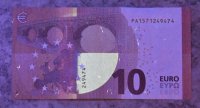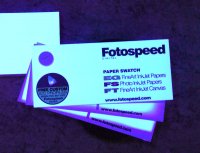- Joined
- Dec 27, 2014
- Messages
- 6,344
- Reaction score
- 7,560
- Points
- 373
- Location
- Germany
- Printer Model
- L805, WF2010, ET8550, T3100X
During all my fade test I made some observations which are not so much printer/Epson or ink related but deal with the optical brighteners in the photo papers in use and with the influence of ozone onto the fading.
It is not possible for me to separate the influence of UV radiation and/or ozone at all, I only can make some assumptions to be discussed later. And I don't have any means to measure ozone, the level, the dose over time which all makes the testing done by Aardenburg or Wilhelm research in their test chambers so expensive.
Optical brighteners, as an additive to the coating of inkjet papers, are colors which are invisible under regular light. They are supposed to get active when exposed to UV light, light with a wavelength close to the visible blue/violet range, they create a light blue color which is supposed to increase the perceived whiteness of a paper. It is used heavily in copy papers as well for this purpose, typical office light from neon tubes emit still some enough of such UV light to create this effect as well.
When buying photo papers you don't know what you get, the OB content is rarely mentioned in product descriptions. The optical brighteners can cause some problems in the profiling process, you can measure the color patches with an instrument which is sensitive to this near UV spectrum or not - using a filter in the spectrometer filtering the internal light source. And profiling software can include or exclude such readings, the inclusion of optical brighteners got pretty complex over the last years .
Let me show you - to start with -

a 10 Euro bill under such UV light, you can get very cheap lamps - flashlights like this one
https://www.amazon.com/Creazy-UV-WF...qid=1494518365&sr=8-27&keywords=uv+flashlight
There are various print elements showing up under UV light to check the validity of this bill.
This is a shot of three photo papers under such light

The top violet one is an HP premium glossy photo paper, the middle and lower ones in lighter cyan are
Aldi/Sihl and Aldi/Netbit papers , I'm using all of them for various printouts. The HP paper does not contain any OB's , the other papers a lot. You barely see any difference under normal light, the Sihl paper looks a bit more yellowish, the Netbit and HP papers both show a neutral white. But when I look to the fading targets currently running outside the optical brighteners are gone after a week or two - they fade faster than any ink on the paper. This raises the question why those OB's are used at all if they fade that quickly ?
I'll show you some more observations in the next days.
It is not possible for me to separate the influence of UV radiation and/or ozone at all, I only can make some assumptions to be discussed later. And I don't have any means to measure ozone, the level, the dose over time which all makes the testing done by Aardenburg or Wilhelm research in their test chambers so expensive.
Optical brighteners, as an additive to the coating of inkjet papers, are colors which are invisible under regular light. They are supposed to get active when exposed to UV light, light with a wavelength close to the visible blue/violet range, they create a light blue color which is supposed to increase the perceived whiteness of a paper. It is used heavily in copy papers as well for this purpose, typical office light from neon tubes emit still some enough of such UV light to create this effect as well.
When buying photo papers you don't know what you get, the OB content is rarely mentioned in product descriptions. The optical brighteners can cause some problems in the profiling process, you can measure the color patches with an instrument which is sensitive to this near UV spectrum or not - using a filter in the spectrometer filtering the internal light source. And profiling software can include or exclude such readings, the inclusion of optical brighteners got pretty complex over the last years .
Let me show you - to start with -

a 10 Euro bill under such UV light, you can get very cheap lamps - flashlights like this one
https://www.amazon.com/Creazy-UV-WF...qid=1494518365&sr=8-27&keywords=uv+flashlight
There are various print elements showing up under UV light to check the validity of this bill.
This is a shot of three photo papers under such light

The top violet one is an HP premium glossy photo paper, the middle and lower ones in lighter cyan are
Aldi/Sihl and Aldi/Netbit papers , I'm using all of them for various printouts. The HP paper does not contain any OB's , the other papers a lot. You barely see any difference under normal light, the Sihl paper looks a bit more yellowish, the Netbit and HP papers both show a neutral white. But when I look to the fading targets currently running outside the optical brighteners are gone after a week or two - they fade faster than any ink on the paper. This raises the question why those OB's are used at all if they fade that quickly ?
I'll show you some more observations in the next days.



